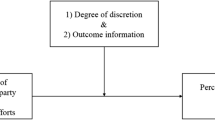Abstract
An investigation of the impact of innovations in civil trial procedure manipulated trial structure (unitary vs. separated trial issues), order of decisions (liability or causation first), and number of decisions made (one to four) in a simulated toxic tort trial. Juries gave verdicts and damage awards. Recordings were made of the juries' deliberations. The results showed significantly more verdicts in favor of the plaintiffs in unitary trials (causation, liability, and damages heard together) as opposed to separated trials. However, average damage awards were higher in the separated than in the unitary trial conditions. Juries assigned more responsibility to the defendant in the unitary trial. Juries also used the totality of the evidence to decide all issues, especially general causation, which contained the most ambiguous testimony. The performance of these simulated juries in complex litigation was discussed in terms of group and individual cognitive factors.
Similar content being viewed by others
References
Dellarosa, D., & Bourne, L. E. (1984). Decisions and memory: Differential retrievability of consistent and contradictory evidence.Journal of Verbal Learning and Verbal Behavior, 23, 669–682.
Devlin, L. (1980). Jury trial of complex cases: English practice at the time of the Seventh Amendment.80 Columbia Law Review. 43–97.
Hans, V., & Ermann, M. D. (1989). Responses to corporate wrongdoing.Law and Human Behavior, 13, 151–166.
Hastie, R., & Park, B. (1986). The relationship between memory and judgment depends on whether the judgment task is memory-based or on-line.Psychological Review, 93, 258–268.
Hensler, D., Felstiner, W. L. F., Selvin, M., & Ebener, P. A. (1985).Asbestos in the courts: The challenge of mass toxic torts. The Institute for Civil Justice. Santa Monica, CA: The Rand Corporation.
Horowitz, I. A., & Bordens, K. S. (1988). The effects of outlier presence, plaintiff population size, and aggregation of plaintiffs on simulated jury decisions.Law and Human Behavior, 12, 209–229.
Hosch, H. M., Marchioni, P. M., Leippe, M. R., & Cooper, D. S. (1984). Victimization, self-monitoring, and eyewitness identification.Journal of Applied Psychology, 69, 280–288.
In re “Agent Orange” Product liability litigation, 565 F. Supp. (1983).
In re Bendectin Litigation, M.D.L., No. 486, Southern District of Ohio (1986).
In re Beverly Hills Fire Litigation, 675 F.2d 207 (6th Cir. 1982)cert. denied, 461, U.S. 929 (1983).
In re Northern district of California “Dalkon shield” IUD Product Liability Litigation, 526 F. Supp. 887, 889, (N.D. Cal. 1981).
In re Union Carbide Corporation Gas Plant Disaster at Bhopal, India in December, 1984. MDL No. 626 Misc. No. 21-88 All cases (S.D.N.Y., May 12, 1986).
MacCoun, R. J. (1987).Getting inside the black box: Toward a better understanding of civil jury behavior. The Institute for Civil Justice. Santa Monica, CA: The Rand Corporation.
Miller, A. R. (1987).Preliminary study of complex litigation. Philadelphia, PA: American Law Institute.
Miller, N., & Campbell, D. T. (1959). Recency and primacy in persuasion as a function of the timing of speeches and measurements.Journal of Abnormal and Social Psychology, 59, 1–9.
Rosenberg, D. (1984). The causal connection in mass exposure cases: A public law vision of the tort system.Harvard Law Review, 97, 4, 1–45.
Selvin, M. & Picus, L. (1987).The debate over jury performance. The Institute for Civil Justice. Santa Monica, CA: The Rand Corporation.
Trangsrud, R. (1985). Joinder alternatives in mass tort litigation.Cornell Law Review, 70, 779–816.
Wilhoite v Olin Corp, (NO. CV-83-5021 NE) (N.D.Ala., 1985).
Willging, T. E. (1987).Trends in asbestos litigation. Federal Judicial Center, Washington, DC.
Wilson, W., & Miller, H. (1968). Repetition, order of presentation, and timing of arguments and measures as determinants of opinion change.Journal of Personality and Social Psychology, 9, 184–188.
Zeisel, H., & Callahan, D. (1967). Split trials and time savings: A statistical analysis.Harvard Law Review, 76, 1606–1629.
Yung v. Raymark Industries., Inc. 789 F.2d 397 (6th Cir., 1986).
Author information
Authors and Affiliations
Additional information
This research was supported by the National Science Foundation under grant No. SES 860 9892. In addition, funding for this research came from a University of Toledo Faculty Development grant; an Academic Challenge grant from the State of Ohio to the Department of Psychology; a grant from the Indiana University—Purdue University at Fort Wayne Instructional Development Support Program. The authors would like to thank Attorney Thomas E. Willging for his helpful and incisive guidance.
About this article
Cite this article
Horowitz, I.A., Bordens, K.S. An experimental investigation of procedural issues in complex tort trials. Law Hum Behav 14, 269–285 (1990). https://doi.org/10.1007/BF01352753
Issue Date:
DOI: https://doi.org/10.1007/BF01352753




